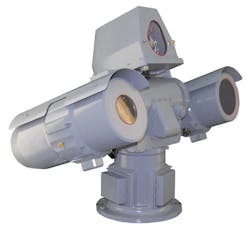Navy asks L3Harris to provide shipboard electro-optical targeting sensors to help warships hit their targets
WASHINGTON – Military electro-optics experts at L3Harris Technologies Inc. will provide shipboard sensors for the fire-control necessary for U.S. Navy and Coast Guard warships to hit enemy ships and aircraft with naval gun fire under terms of a $13.7 million order announced Friday.
Officials of the Naval Sea Systems Command in Washington are asking the L3Harris KEO segment in Northampton, Mass., to produce additional MK 20 electro-optical sensor systems (EOSS), radar cross sections kits, shock ring kits, and spare parts for the Navy and Coast Guard.
The EOSS electro-optics system is a check sight and targeting sensor for anti-surface and anti-air warfare and naval gun fire support missions, Navy officials say.
The MK 20 EOSS is a major component of the MK 34 5-inch guns aboard Navy Arleigh Burke-class destroyers and Ticonderoga-class cruisers, as well as aboard the U.S. Coast Guard Offshore Patrol Cutter, for use against enemy ships, boats, and aircraft.
L-3 KEO has been building the EOSS since 2005. That year L3-KEO won a Navy contract to provide the EOSS for the Ticonderoga-class Cruiser Modernization Program. Company electro-optical engineers built on the MK 46 Optical Sight System to blend new technologies into the MK 20 shipboard MOD 0 EOSS, as well as integrate the system into the MK 34 5-inch deck guns.
The MK 20 EOSS has digital stabilization with fiber-optic gyros, a separate eye-safe laser rangefinder with diode-pumped laser, enhanced built-in test, and improved sensor-to-sensor boresight alignment. The EOSS meets MIL-S-901D heavyweight and large-displacement shock tests.
The MK 20 MOD 0 incorporates several technology improvements over the MK 46, and new features that support integration with the MK 34 Gun Weapons System (GWS).
To integrate with the MK 34 deck gun, the EOSS has a new interface electronics unit (IEU) that interfaces with as many as two deck gun computers and three deck gun consoles to provide video, target bearing and range, and system status data to all three, while taking commands from any one, L-3 officials say.
On this contract modification L-3 will do the work in Northampton, Mass., and should be finished by April 202y. For more information contact L3Harris KEO online at www.l3harris.com, or Naval Sea Systems Command at www.navsea.navy.mil.

John Keller | Editor-in-Chief
John Keller is the Editor-in-Chief, Military & Aerospace Electronics Magazine--provides extensive coverage and analysis of enabling electronics and optoelectronic technologies in military, space and commercial aviation applications. John has been a member of the Military & Aerospace Electronics staff since 1989 and chief editor since 1995.

